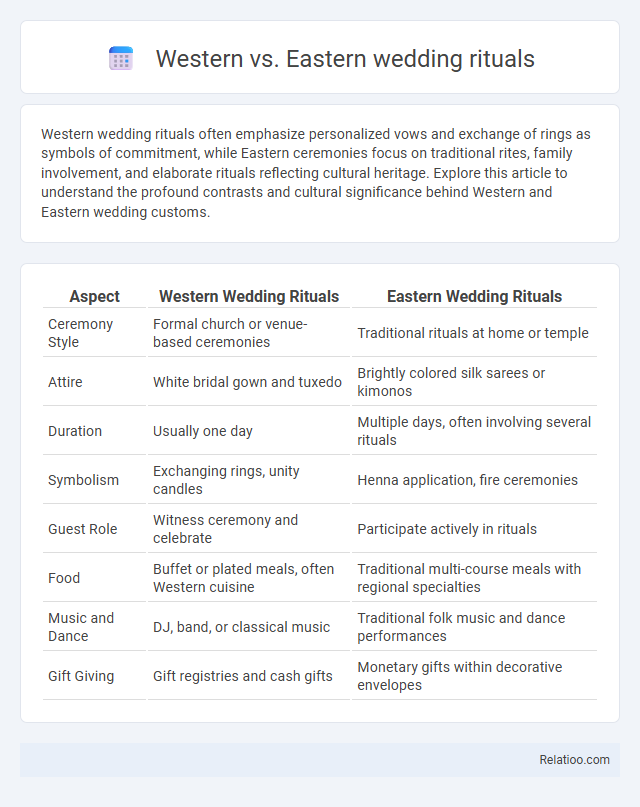Western wedding rituals often emphasize personalized vows and exchange of rings as symbols of commitment, while Eastern ceremonies focus on traditional rites, family involvement, and elaborate rituals reflecting cultural heritage. Explore this article to understand the profound contrasts and cultural significance behind Western and Eastern wedding customs.
Table of Comparison
| Aspect | Western Wedding Rituals | Eastern Wedding Rituals |
|---|---|---|
| Ceremony Style | Formal church or venue-based ceremonies | Traditional rituals at home or temple |
| Attire | White bridal gown and tuxedo | Brightly colored silk sarees or kimonos |
| Duration | Usually one day | Multiple days, often involving several rituals |
| Symbolism | Exchanging rings, unity candles | Henna application, fire ceremonies |
| Guest Role | Witness ceremony and celebrate | Participate actively in rituals |
| Food | Buffet or plated meals, often Western cuisine | Traditional multi-course meals with regional specialties |
| Music and Dance | DJ, band, or classical music | Traditional folk music and dance performances |
| Gift Giving | Gift registries and cash gifts | Monetary gifts within decorative envelopes |
Introduction to Western and Eastern Wedding Traditions
Western wedding traditions typically emphasize personalized vows, white bridal gowns, and the exchange of rings symbolizing lifelong commitment. Eastern wedding rituals often include elaborate ceremonies rich in symbolism, such as tea ceremonies, henna application, and traditional attire representing cultural heritage. Understanding these contrasting customs can help you appreciate the diverse expressions of love and unity across cultures.
Cultural Foundations of Marriage Ceremonies
Western wedding rituals often emphasize legal and religious traditions rooted in Judeo-Christian values, symbolizing the union through vows, rings, and ceremonies conducted in churches or secular venues. Eastern wedding rituals incorporate intricate cultural customs such as Hindu fire ceremonies, Chinese tea rituals, and Japanese sake-sharing, reflecting deep philosophical beliefs about harmony, family, and spiritual blessings. The cultural foundations of marriage ceremonies across both regions highlight the social importance of uniting families, community involvement, and perpetuating heritage through symbolic acts tailored to distinct historical and spiritual contexts.
Pre-Wedding Rituals: Contrasts and Similarities
Western pre-wedding rituals often include bridal showers, bachelor or bachelorette parties, and rehearsal dinners that emphasize social celebration and preparation for the ceremony. Eastern pre-wedding rituals typically involve multiple culturally rich ceremonies such as the Mehndi, Sangeet, and Haldi, which hold symbolic significance and involve family participation. Your wedding planning benefits from understanding these contrasts and similarities, as both traditions focus on honoring family bonds, blessing the couple, and creating memorable preparations ahead of the big day.
Symbolic Attire and Wedding Attire Customs
Western wedding attire typically features a white dress symbolizing purity, with the groom in a formal suit or tuxedo, while Eastern wedding rituals emphasize vibrant colors like red or gold to represent prosperity and good luck. Your choice of symbolic attire in these ceremonies reflects cultural values, where Western customs prioritize simplicity and elegance, and Eastern traditions embrace intricate designs and ornate jewelry. Understanding these wedding attire customs highlights the deep cultural significance embedded in each region's celebration of marriage.
Religious Influences on Wedding Rituals
Religious influences significantly shape both Western and Eastern wedding rituals, with Western ceremonies often rooted in Christian traditions such as vows exchanged before a priest and rings symbolizing eternal commitment. Eastern weddings, influenced by Hinduism, Buddhism, and Islam, frequently include rituals like the Hindu pheras, Buddhist blessings, or Islamic nikah to invoke divine blessings on the union. Your choice of wedding ritual reflects these religious elements, emphasizing the spiritual values and cultural heritage that define the ceremony.
The Wedding Ceremony Structure
Western wedding ceremonies typically follow a structured sequence including the procession, exchange of vows, ring ceremony, and pronouncement of marriage, often held in religious or civil settings. Eastern wedding rituals vary widely but commonly involve elaborate pre-wedding ceremonies, symbolic rites such as the tea ceremony or fire rituals, and multiple days of celebration reflecting cultural heritage. Your wedding ceremony structure can blend elements from both traditions, creating a personalized experience that honors meaningful customs while maintaining a clear, organized flow.
Significance of Family and Community Participation
Western wedding rituals emphasize the couple's union with symbolic family involvement through activities like giving away the bride and toasts, reinforcing social bonds. Eastern wedding ceremonies highlight extensive family and community participation, with rituals such as the tea ceremony and collective blessings reflecting deep-rooted cultural values. The significance of family and community participation in weddings fosters unity, support, and continuity of traditions across both cultural contexts.
Post-Wedding Traditions and Festivities
Western post-wedding traditions typically include the bride and groom departing amid a celebratory send-off, such as rice or confetti throwing, followed by a reception featuring speeches and dancing. In contrast, Eastern wedding rituals often involve extended festivities like the bride's departure ceremony, multiple days of family gatherings, and religious rites that honor ancestors and cultural heritage. Understanding the richness of both Western and Eastern post-wedding customs allows you to appreciate diverse ways communities celebrate the union beyond the ceremony itself.
Modern Adaptations and Cross-Cultural Trends
Modern wedding rituals increasingly blend Western and Eastern traditions, exemplified by couples incorporating Western white gowns with Eastern tea ceremonies to honor diverse cultural heritages. You can witness cross-cultural trends such as fusion menus, mixed attire, and hybrid ceremonies gaining popularity, reflecting global interconnectedness and personalization in weddings. These adaptations showcase evolving values emphasizing inclusivity, symbolism, and unique storytelling in matrimonial celebrations.
Conclusion: Celebrating Diversity in Nuptial Rituals
Wedding rituals across Western and Eastern traditions showcase diverse cultural values and symbolic practices, reflecting unique approaches to love, family, and spirituality. Your celebration embodies a fusion of these rich customs, emphasizing unity and respect for heritage. Embracing this diversity enriches the nuptial experience, making each wedding a meaningful testament to global cultural interconnectedness.

Infographic: Western vs Eastern wedding rituals
 relatioo.com
relatioo.com